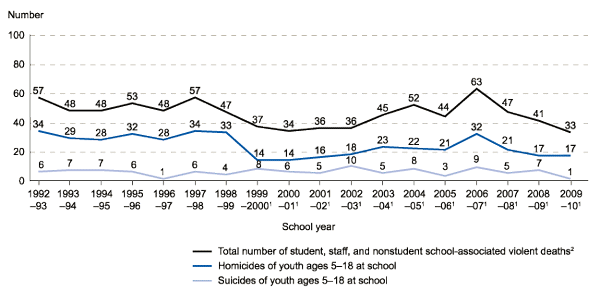School-Associated Violent Death Study
Background
CDC has been collecting data on school-associated violent deaths since 1992. The system, which was developed in partnership with the Departments of Education and Justice, monitors school-associated violent deaths at the national level. Information is collected each year from media databases, police, and school officials. The School-Associated Violent Death Study (SAVD) presents the most recent data available on school-associated violent deaths; common features of these events; and potential risk factors for perpetration and victimization. Data obtained from this study play an important role in monitoring and assessing national trends in school-associated violent deaths, and help to inform efforts to prevent fatal school violence.
Case Definition
A case is defined as a fatal injury (e.g., homicide, suicide, or legal intervention) that occurs on school property, on the way to/from school, or during or on the way to/from a school-sponsored event. Only violent deaths associated with U.S. elementary and secondary schools, both public and private, are included.
Major Findings
Generic Textbox module not found-
Most school-associated violent deaths occur during transition times – immediately before and after the school day and during lunch. 1
-
Violent deaths are more likely to occur at the start of each semester.2
-
Nearly 50 percent of homicide perpetrators gave some type of warning signal, such as making a threat or leaving a note, prior to the event.1
-
Firearms used in school-associated homicides and suicides came primarily from the perpetrator’s home or from friends or relatives.3
-
Homicide is the second leading cause of death among youth aged 5-18. Data from this study indicate that between 1% and 2% of these deaths happen on school grounds or on the way to or from school. These findings underscore the importance of preventing violence at school as well as in communities.
Trends in School-Associated Violent Deaths—1992-2010

Footnotes:
1The data from 1999—2000 onward are subject to change as additional information about confirmed cases is received and assessed. Reasons for change include but are not limited to: a) Reclassification of cases as non-cases based on specific details learned during the interviews with school and law enforcement officials; and b) identification of new cases in prior data years. The latter situation occasionally occurs because some cases did not appear in media databases during the case identification period for specific years and were not identified by supplemental case finding efforts.
Such cases are sometimes discovered in subsequent database expansions, in ongoing supplemental case finding efforts, and in law enforcement and school interviews conducted to verify known cases.
2Victims include students, staff members, and others who are not students, from July 1, 1992, through June 30, 2010.
3Estimates were revised and may differ from previously published data.
4At school refers to on school property, on the way to/from school, or during or on the way to/from a school-sponsored event.
Additional findings on violent deaths from CDC’s School-Associated Violent Death Study are available in the Indicators of School Crime and Safety published annually by the Departments of Education and Justice http://nces.ed.gov/pubsearch/pubsinfo.asp?pubid=20130364 This report also includes the most recent data available on school crime and safety.
References:
-
Anderson M, Kaufman J, Simon TR, Barrios L, Paulozzi L, Ryan G, et al. School-associated violent deaths in the United States, 1994–1999. JAMA 2001;286(21):2695–2702.
-
Centers for Disease Control and Prevention. Temporal variations in school-associated student homicide and suicide events – United States, 1992–1999. MMWR 2001;50(31):657–660.
-
Centers for Disease Control and Prevention. Source of firearms used by students in school-associated violent deaths – United States, 1992–1999. MMWR 2003;52(09):169–172.
-
Robers S, Zhang J, Truman J, Snyder TD. Indicators of School Crime and Safety, 2011. National Center for Education Statistics, U.S. Department of Education and Bureau of Justice Statistics, Office of Justice Programs, U.S. Department of Justice. Washington, DC; 2012.
- Page last reviewed: January 27, 2014
- Page last updated: May 11, 2016
- Content source:


 ShareCompartir
ShareCompartir
